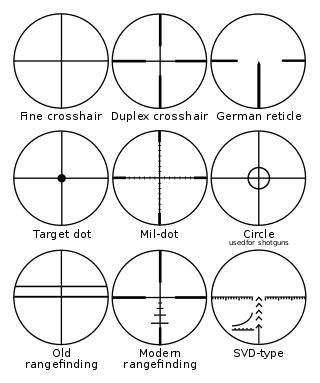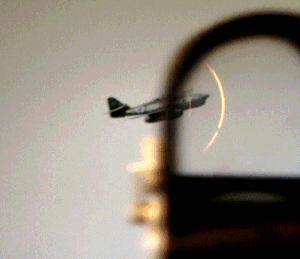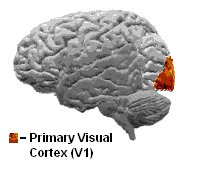This article needs additional citations for verification .(January 2017) |

Superimposition is the placement of one thing over another, typically so that both are still evident.
This article needs additional citations for verification .(January 2017) |

Superimposition is the placement of one thing over another, typically so that both are still evident.
In graphics, superimposition is the placement of an image or video on top of an already-existing image or video, usually to add to the overall image effect, but also sometimes to conceal something (such as when a different face is superimposed over the original face in a photograph).
This technique is used in cartography to produce photomaps by superimposing grid lines, contour lines and other linear or textual mapping features over aerial photographs.
Superimposition of two-dimensional images containing correlated periodic grid structures may produce moiré patterns. Superimposition of two correlated layers comprising parallel lines or curves may give rise line moiré patterns. The movement of one of the layers results in a faster movement of the line moiré superimposition image. Such optical acceleration is known as moiré speedup (check for the formulas of optical speedup for curved patterns). When superimposing two identical layers comprising randomly spaced parallel lines, at a small angle or with a small scaling difference random line moiré patterns, [1] namely line Glass patterns (after Leon Glass, 1969) appear. Similarly, when superimposing two identical layers of randomly scattered dots at a small angle or with a small scaling difference random dot Glass patterns, namely random dot moiré, [2] appears. When one of the layers embeds complex shapes, such as sequences of symbols forming a text, and another layer contains parallel lines or curves, the superimposition image may give rise to magnified shapes, called shape moiré patterns.
Photographic superimposition is a forensic technique. This can include craniofacial superimposition, which compares skulls of the deceased with images of them through the overlap of photographs. [3]
Superimposition (SI) during sound recording and reproduction (commonly called overdubbing) is the process of adding new sounds over existing without completely erasing or masking the existing sound. Some reel-to-reel tape recorders of the mid 20th century provided crude superimposition facilities that were implemented by killing the high-frequency AC feed to the erase head while recording as normal via the read-write head.

Optics is the branch of physics that studies the behaviour and properties of light, including its interactions with matter and the construction of instruments that use or detect it. Optics usually describes the behaviour of visible, ultraviolet, and infrared light. Because light is an electromagnetic wave, other forms of electromagnetic radiation such as X-rays, microwaves, and radio waves exhibit similar properties.

The Williams tube, or the Williams–Kilburn tube named after inventors Freddie Williams and Tom Kilburn, is an early form of computer memory. It was the first random-access digital storage device, and was used successfully in several early computers.

A dot matrix is a 2-dimensional patterned array, used to represent characters, symbols and images. Most types of modern technology use dot matrices for display of information, including mobile phones, televisions, and printers. The system is also used in textiles with sewing, knitting and weaving.

Halftone is the reprographic technique that simulates continuous-tone imagery through the use of dots, varying either in size or in spacing, thus generating a gradient-like effect. "Halftone" can also be used to refer specifically to the image that is produced by this process.

In mathematics, physics, and art, moiré patterns or moiré fringes are large-scale interference patterns that can be produced when a partially opaque ruled pattern with transparent gaps is overlaid on another similar pattern. For the moiré interference pattern to appear, the two patterns must not be completely identical, but rather displaced, rotated, or have slightly different pitch.

The Ben Day process is a printing and photoengraving technique for producing areas of gray or various colors by using fine patterns of ink on the paper. It was developed in 1879 by illustrator and printer Benjamin Henry Day Jr.. The process is commonly described in terms of Ben Day dots, but other shapes can be used, such as parallel lines or textures.

An autostereogram is a two-dimensional (2D) image that can create the optical illusion of a three-dimensional (3D) scene. Autostereograms use only one image to accomplish the effect while normal stereograms require two. The 3D scene in an autostereogram is often unrecognizable until it is viewed properly, unlike typical stereograms. Viewing any kind of stereogram properly may cause the viewer to experience vergence-accommodation conflict.

A reticle, or reticule also known as a graticule, is a pattern of fine lines or markings built into the eyepiece of an optical device such as a telescopic sight, spotting scope, theodolite, optical microscope or the screen of an oscilloscope, to provide measurement references during visual inspections. Today, engraved lines or embedded fibers may be replaced by a digital image superimposed on a screen or eyepiece. Both terms may be used to describe any set of patterns used for aiding visual measurements and calibrations, but in modern use reticle is most commonly used for weapon sights, while graticule is more widely used for non-weapon measuring instruments such as oscilloscope display, astronomic telescopes, microscopes and slides, surveying instruments and other similar devices.

Frederic Eugene Ives was a U.S. inventor who was born in Litchfield, Connecticut. In 1874–78 he had charge of the photographic laboratory at Cornell University. He moved to Philadelphia, Pennsylvania, where in 1885 he was one of the founding members of the Photographic Society of Philadelphia. He was awarded the Franklin Institute's Elliott Cresson Medal in 1893, the Edward Longstreth Medal in 1903, and the John Scott Medal in 1887, 1890, 1904 and 1906. He was elected to the American Philosophical Society in 1922. His son Herbert E. Ives was a pioneer of television and telephotography, including color facsimile.

Laser engraving is the practice of using lasers to engrave an object. Laser marking, on the other hand, is a broader category of methods to leave marks on an object, which in some cases, also includes color change due to chemical/molecular alteration, charring, foaming, melting, ablation, and more. The technique does not involve the use of inks, nor does it involve tool bits which contact the engraving surface and wear out, giving it an advantage over alternative engraving or marking technologies where inks or bit heads have to be replaced regularly.

Hatching is an artistic technique used to create tonal or shading effects by drawing closely spaced parallel lines. When lines are placed at an angle to one another, it is called cross-hatching. Hatching is also sometimes used to encode colours in monochromatic representations of colour images, particularly in heraldry.
Cromaclear is a trademark for CRT technology used by NEC during the mid to late-90s. This adopted the slotted shadow mask and in-line electron gun pioneered by the 1966 GE Porta-Color and used by most then-current television tubes to computer monitor use. It was claimed that Cromaclear could offer the image clarity and sharpness of the Trinitron and Diamondtron aperture grille CRTs without the disadvantages e.g. expense and the horizontal damping wires.
In computer graphics, image tracing, raster-to-vector conversion or raster vectorization is the conversion of raster graphics into vector graphics.

Line art or line drawing is any image that consists of distinct straight lines or curves placed against a background, without gradations in shade (darkness) or hue (color) to represent two-dimensional or three-dimensional objects. Line art can use lines of different colors, although line art is usually monochromatic.
Line moiré is one type of moiré pattern; a pattern that appears when superposing two transparent layers containing correlated opaque patterns. Line moiré is the case when the superposed patterns comprise straight or curved lines. When moving the layer patterns, the moiré patterns transform or move at a faster speed. This effect is called optical moiré speedup.
Shape moiré is one type of moiré patterns demonstrating the phenomenon of moiré magnification. 1D shape moiré is the particular simplified case of 2D shape moiré. One-dimensional patterns may appear when superimposing an opaque layer containing tiny horizontal transparent lines on top of a layer containing a complex shape which is periodically repeating along the vertical axis.

Security holograms are labels with a hologram printed onto it for sale security reasons.

A reflector sight or reflex sight is an optical sight that allows the user to look through a partially reflecting glass element and see an illuminated projection of an aiming point or some other image superimposed on the field of view. These sights work on the simple optical principle that anything at the focus of a lens or curved mirror will appear to be sitting in front of the viewer at infinity. Reflector sights employ some sort of "reflector" to allow the viewer to see the infinity image and the field of view at the same time, either by bouncing the image created by lens off a slanted glass plate, or by using a mostly clear curved glass reflector that images the reticle while the viewer looks through the reflector. Since the reticle is at infinity it stays in alignment with the device to which the sight is attached regardless of the viewer's eye position, removing most of the parallax and other sighting errors found in simple sighting devices.

Orientation columns are organized regions of neurons that are excited by visual line stimuli of varying angles. These columns are located in the primary visual cortex (V1) and span multiple cortical layers. The geometry of the orientation columns are arranged in slabs that are perpendicular to the surface of the primary visual cortex.
Leon Glass is an American scientist who has studied various aspects of the application of mathematical and physical methods to biology, with special interest in vision, cardiac arrhythmia, and genetic networks.